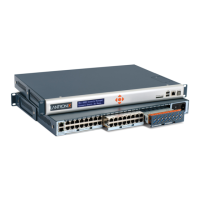8: Device Ports
SLC™ 8000 Advanced Console Manager User Guide 153
6. Click Apply.
Dial-back Number Users with Dial-back can dial into the SLC unit and enter their login and
password. Once the SLC unit authenticates them, the modem hangs up and
dials them back .
Select the phone number the modem dials back on: a fixed number or a
number associated with their login. If you select Fixed Number, enter the
number (in the format 2123456789).
The dial-back number is also used for CBCP client as the number for a user-
defined number. See CBCP Server and CBCP Client for more information.
Dial-back Delay For dial-back and CBCP Server, the number of seconds between the dial-in
and dial-out portions of the dialing sequence.
Dial-back Retries For dial-back and CBCP Server, the number of times the SLC unit will retry the
dial-out portion of the dialing sequence if the first attempt to dial-out fails.
Timeout Logins If you selected text mode, you can enable logins to time out after the
connection is inactive for a specified number of minutes. The default is No. This
setting only applies to text mode connections. PPP mode connections stay
connected until either side drops the connection. Disabled by default.
Negotiate IP Address If the SLC and/or the serial device have dynamic IP addresses (e.g., IP
addresses assigned by a DHCP server), select Yes. This is the default.
If the SLC unit or the modem have fixed IP addresses, select No, and enter the
Local IP (IP address of the internal modem) and Remote IP (IP address of the
modem).
Authentication Enables PAP or CHAP authentication for modem logins. PAP is the default.
With PAP, users are authenticated by means of the Local Users and any of the
remote authentication methods that are enabled.
With CHAP, the CHAP Handshake fields authenticate the user.
CHAP Handshake The Host/User Name (for UNIX systems) or
Secret/User Password (for Windows systems) used for CHAP authentication.
May have up to 128 characters.
CHAP Auth Uses For CHAP authentication, determines what is used to validate the CHAP host/
user sent by the remote peer: either the CHAP Host defined for the modem, or
any of the users in the Local Users list.
Enable NAT Select to enable Network Address Translation (NAT) for dial-in and dial-out
PPP connections on a per modem (device port, USB port, or internal modem)
basis. Users dialing into the SLC unit access the network connected to Eth1
and/or Eth2.
Note: IP forwarding must be enabled on the Network Settings (on page 54) for
NAT to work.
Dial-out Number Phone number for dialing out to a remote system or serial device. May have up
to 20 characters. Any format is acceptable.
Remote/Dial-out Login User ID for authentication when dialing out to a remote system, or if a remote
system requests authentication from the SLC module when it dials in. May have
up to 32 characters.
Remote/Dial-out
Password/ Retype
Password for authentication when dialing out to a remote system, or if a remote
system requests authentication from the SLC unit when it dials in. May have up
to 20 characters.
Restart Delay The number of seconds after the timeout and before the SLC module attempts
another connection. The default is 30 seconds.

